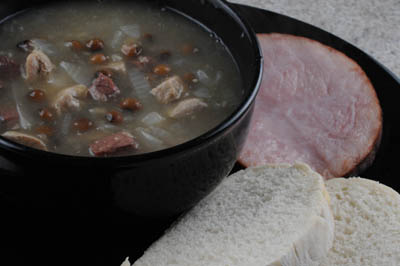 |
| The Bajan staple Christmas meal, jug jug with boiled ham. |
Of course, though it is considered a Caribbean nation, Barbados is actually situated 62 miles east of the Caribbean sea, in the western part of the North Atlantic. Lucky for its 284,589 permanent residents, it is outside the principal Atlantic hurricane belt, which is good for general day-to-day existence as well as being good for the tourist trade. It is both an independent state and a commonwealth nation, which means that Bajans consider England's Queen Elizabeth II to be the head of state of their little 166 square mile island paradise.
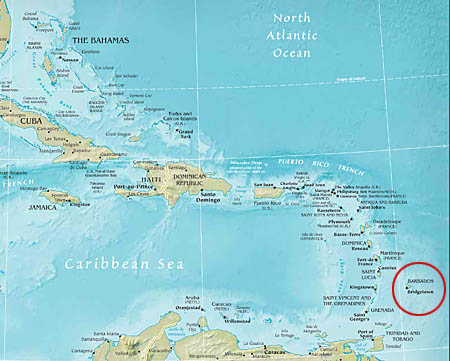 |
| Barbados is over there in the corner. |
Despite being one of the most popular Caribbean destinations, Barbados is sadly lacking in online sources for local recipes. The one site I found that seemed to have a good collection was riddled with comments from Barbados locals (who call themselves "Bajan") about inaccuracies and errors in authenticity. So the recipe I've been planning to do for the last couple of weeks (Bajan Pepper Pot) I had to scratch at the last minute because it didn't include the ubiquitous ingredient, a flavoring called "casareep," which is evidently the single most important element of any Bajan Pepper Pot.
So once again I was down to the wire, and ended up settling for a dish called jug jug, which is actually a holiday recipe served at most Christmas celebrations on the island. Here is the version I used, though I am now actually kind of hopeful that there are better ones out there:
Jug-Jug
(from My Barbados)
- 2 cups green pigeon peas
- 1 lb salt beef (otherwise known as corned beef)
- 1 lb cooked pork
- 2 cups guinea corn or cassava flour
- 1 bouquet garni of thyme, chives, parsley and bay
- 2 large chopped onions
- 1 – 2 tablespoons cooking oil
- 2 garlic cloves, crushed
- Water for cooking
- Salt to taste
Take a ham. Boil it.
On the side I decided I wanted to do "salt bread," which is actually one of the only non-sweet breads eaten on Barbados. Unfortunately the recipe for salt bread is evidently closely guarded, and what I initially found was a recipe on that same website, which like all the other recipes on that site included several comments from Bajans decrying its complete and utter lack of authenticity. The other thing I found was a reference to a salt bread recipe that appears in a Caribbean vegan cookbook (huh?), which the author didn't seem willing to part with without an $8.99 download fee. Since I'm not a vegan that really wasn't a price I wanted to pay for one recipe, and though I was almost desperate enough to do it I'm glad I didn't, since as it turns out the traditional recipe calls for that decidedly non-vegan ingredient: lard.
Hey did you know lard is health food? I am not actually kidding.
I never buy lard, I mean never-never. Because like most people I equate lard with getting fat (well, fatt-er) and with having veins that contain mere pinholes instead of actual channels because of all that artery-clogging stuff floating around in them. Well as it turns out, lard is actually quite a bit healthier than butter, with fully double the monounsaturated fat (the stuff they say is actually good for your heart) and 20% less saturated fat. I know, I couldn't believe it either. Of course the stuff you buy at the supermarket is pretty substandard because it's been hydrogenated, which means it's full of trans fats, which we all know are Evil and Bad. But of course that's what I ended up buying because you can't find anything else at a regular supermarket, and I was out of time. And because I wasn't about to try rendering my own lard, at least not with just 8 hours left before I had to start cooking.
Anyway as you've probably already guessed I did finally find a salt bread recipe without having to go vegan, and here it is:
(I got this recipe from a GIF I found online and have lost the bookmark. Does anyone recognize it? I'd like to credit the original source.)
- 3 1/2 cups white flour
- 3 3/4 tsp active dry yeast
- 1 1/2 tsp salt
- 3 1/2 tsp turbinado sugar
- 2 tbsp lard
- 1 cup water
- 1 tbsp shortening
- 2 1/2 cups coconut
- 4 cups flour
- 1 tbsp baking powder
- 1 tsp salt
- 3/4 cup sugar
- 1 cup raisins
- 1 egg, beaten
- 1 1/4 cups evaporated milk
- 1/2 cup melted butter
- 1 tsp almond essence
- 2 tbsp sugar
- 1 tbsp hot water
This recipe makes two loaves of bread, so first grease two loaf pans with shortening and set your oven to 350 degrees.
Now mix the dry ingredients with the raisins in a large bowl. I just used the pre-shredded coconut you can get in the baking section of any grocery store, which is sweetened, but not so sweetened that you have to adjust the sugar in the recipe to make it come out right.
 |
| Mix the dry ingredients with the raisins. |
Now add the egg, milk, butter and almond essence. Mix until you have a firm dough. (Remember the Johnny cakes from the Bahamas? This dough is similar.)
Divide the dough in half and press it down into the loaf pans. Now mix the sugar and hot water and, using a pastry brush, brush the tops of each loaf. This gives the bread a really nice, sweet and crispy crust on the top.
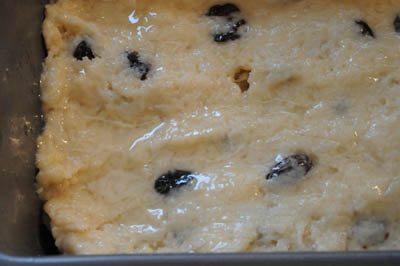 |
| Brushing the top with warm sugar water creates a sweet, crispy crust. |
Bake for one hour, or until a toothpick comes out clean. Let cool, then remove from pans. Slice and serve!
 |
| This is good with a hot cup of tea. |
The next thing I did was bake the salt bread. This recipe works great in a bread machine, but in case you don't have one here are the old-fashioned instructions:
Put all the ingredients except the water into a large bowl and blend until you get fine crumbs.
Add the water and knead for two minutes, then let rise until doubled in size.
 |
| This salt bread is rising really well. |
Punch down and divide into four equal portions. Brush with water and turn over. Let rest for 15 minutes, then turn over again and let rest for another 15 minutes.
Sprinkle the tops of the rolls with flour and place them in a preheated 325 degree oven for 15 minutes or until golden (mine took more like 25 or 30 minutes, so make sure you watch them). This is a really soft bread, so your rolls aren't going to sound too hollow when you knock on them. Go by color instead.
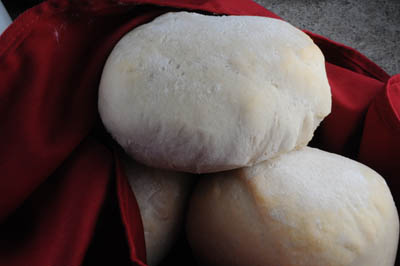 |
| Bake until golden. Mine could have been goldener, but they didn't suffer. |
Now on to the jug jug. I did serve this with boiled ham. (As a guideline, boil your ham for about 15 to 20 minutes per pound. If you're using a raw ham, make sure the center reaches 160 degrees.)
This recipe calls for green pigeon peas. The ones I used were left over from some of my other Caribbean adventures, and I have a feeling they were not the green ones (based on the fact that they were not, um, green). If I did this recipe again (which I can tell you right now is not very likely) I would use canned pigeon peas. The dry ones are a bear to get tender enough, even when soaked for a pretty long period of time.
So there may be a disconnect between what a Bajan would call salt beef, and what we would call salt beef (which you may know only as corned beef). First of all don't buy the canned stuff, that's not at all the same thing. You can get fresh corned beef at the deli counter of most supermarkets (though I did have to go to Raley's because Safeway didn't have it). I don't know, though, if the deli stuff is similar to the salt beef you would get in Barbados. Based on these instructions for making jug jug, I suspect that Bajan salt beef might be dried, though someone please correct me if I'm wrong.
Anyway, I forged ahead as if my salt beef was exactly the same as the Bajan kind, which meant that I cut it into small pieces, covered it with water and brought it just to a boil. Then I drained the water and covered it with cold water and stuck it in the fridge for two or three hours.
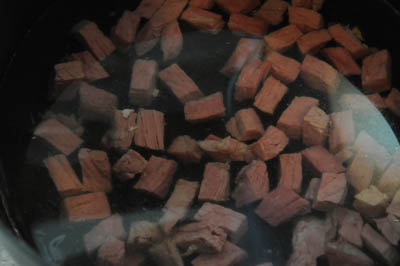 |
| Soak the salt beef in cold water. I think. |
Meanwhile, I cooked some basic pork stew meat in a pan.
About an hour before you want to be eating, pour a little bit of oil in a heavy pot and heat until it starts to smoke. Then add the onions and saute until they start to become translucent. Add the garlic and keep cooking until fragrant.
Put the pigeon peas in the pot and stir for another five or 10 minutes.
 |
| Cook the pigeon peas until the skins start to wrinkle and split. |
The recipe says to cook "until the skins burst," which never happened in my pot because my pigeon peas were like little pebbles. Now add the meats, the bouquet garni and just enough water to cover, and bring to a boil. Reduce heat and simmer until the meats are soft, for about an hour or so. Remove and discard the bouquet garni.
 |
| This, by the way, is a bouquet garni--a simple bunch of herbs tied with a piece of kitchen string. |
Now comes the weird part. Cassava flour is not something you can get at an American market, obviously, but it just so happened I had some because I ordered it a few weeks ago from an Amazon.com marketplace seller. It kept popping up in a lot of Caribbean recipes, so I figured it was something I ought to have on hand.
Cassava flour looks just like regular flour but it smells a bit odd. In fact when I first smelled it it gave me a quick flash back to my childhood, not because it smelled like something we used to eat when I was a kid but because it smelled like something my mom used to feed her birds.
Anyway the recipe says to mix it with just enough water so that there are no more lumps, which means you end up with really thick porridgey stuff.
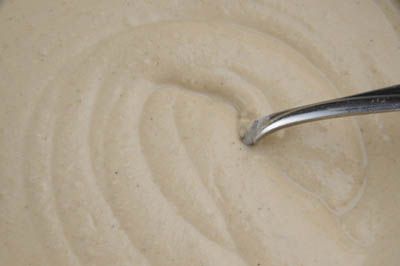 |
| This stodgy looking stuff is cassava flour mixed with water. |
Then you are supposed to put all of that in the pot, which instantly turns the water into a clear, thick mass that looks like plain Jell-O. Now add salt. Taste. Now try to save the recipe with even more salt. Now stare at the pot with a growing sense of unease and wonder what you're going to say to your family.
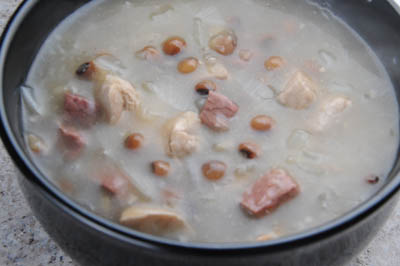 |
| Finished jug jug. I'm sorry to say I did not like this at all. |
I mean no disrespect to Bajans, who I know enjoy this meal since it is a holiday staple. I just don't think my tastebuds are programmed like theirs are, or else something went terribly wrong in my interpretation of this recipe (which is pretty similar to other versions I found elsewhere online). If I was the kind of person who gave one-star reviews on Food.com, though, I might be tempted to begin my review with the words "if I could only give this half a star, I would," and then I would end it with the word "YUCK" in all caps, with a bunch of exclamation points. But I am not the nasty, mean-spirited sort of person who gives one star recipe reviews so I really just prefer to think that my tastes are not suited to this particular recipe. Neither were Martin's. We really didn't like it at all. It looked horrible, like wet gelatin with meat and peas in it. And it was bland.
The boiled ham was good though, because, you know, it was just ham. That had been boiled.
On the other end of the spectrum was the salt bread, which came out absolutely perfectly and was delicious. It was soft and yeasty and tasted great with just a little bit of butter. And the sweet bread was also oh-so yummy, with a wonderful crispy, sugary crust on top and delicious little bits of coconut inside (and I'm not even someone who usually likes coconut in sweet foods). We couldn't stop eating it, probably in part because we were hungry from not eating the jug jug but also because it was just plain good.
And with the leftover ham and a little South-Western style mustard, the salt bread made a really awesome sandwich the day after.
Next week: Bassas da India, which has no population (either native or non-native). Bet you can't wait to see how I'm going to manage this one ....
For printable versions of this week's recipes:











I love your efforts, but please don't equate what's in that pot with jug jug! Jug is almost like refried beans in texture - but a bit wetter. It is INCREDIBLY delicious and I do hope you get a chance to try it sometime. It is my favorite part of the Xmas meal.
ReplyDeleteOh, and I know what you mean about the vegan in the sun author. She is the one that claimed salt bread is a secret recipe (it's not!) and the way she acts, her recipes are only worth passing on if you 'buy de book'!. Barbados desperately needs some good food bloggers. I do not consider her or her her blog a good representative for the island or its cuisine. Try Tastes like Home by Cynthia Nelson. She also guards her recipes but not quite as obsessively as the other.
ReplyDeleteOh TJ if you have a recipe for jug jug I would LOVE to do that one over! I really felt like something must have gone horribly wrong with that recipe ... either it just wasn't a very good version or I just did it completely wrong. All the recipes I found for it were like this one, but it really just came out badly for some reason. I would love to try it again. Thanks for posting!
ReplyDeleteI will try and get a recipe for you. I don't make it myself (never have) but I have a Bajan friend that used to make it *almost* as good as the one you get in Barbados. The guinea corn flour is just irreplaceable I think - in fact, you used to be only able to get it at this time of year in Barbados. I could be wrong, but I will ask and let you know. Just as an FYI, I know that it may sound biased (but trust me, it's really not) Barbados has the BEST food in all the Caribbean! The flying fish are amazing.. the seasoning is spectacular! There is a copy of the seasoning here if you want to try it: http://ladyjanellewellyn.blogspot.com/2008/01/bajan-seasoning-perfect-pinch.html
ReplyDeleteThanks for the link! Sure wish I knew where to buy flying fish, I'd love to try it. And let me know if you are able to track down that jug jug recipe. :)
ReplyDeleteHere is a recipe for jug jug from my Bajan cookbook (a good one). I have not made it, but everything I have made from this book has been good:
ReplyDelete4 cups water
8 pints green pigeon peas**
1/2 lb salt meat ready soaked
1/2 lb pork
1/4 lb green seasoning ("lady janes a perfect pinch" is a good recipe)
3 springs fresh thyme
3 stems fresh marjoram
1 cup guinea corn flour
salt and pepper
2 Tbl butter
** ready cooked tinned pigeon peas or re-hydrated dried pigeon peas may be used for jug-jug.
Boil peas in water and drain. Reserve water. Cut salt meat in small pieces. Cook with pork, seasoning and herbs in reserved water. Grind peas, meat and seasoning together and set aside, again reserving liquid.
Add guinea corn flour to reserved liquid and cook to a thick porridge. Add portions of reserved liquid as needed. Add pea and meat mixture, salt and pepper, and mix thoroughly. steam over medium heat 30 mins stirring often until mixture leaves side of pot. Dish into hot bowl, smooth with butter, and keep covered.
Modern note: jug jug provides excellent nutrition. it freezes well for long periods and really should be used more often throughout the year (we only have it at Xmas). A good light supper would be cups of light soup, hot jug jug on toast points, a little sliced ham, green salad and fresh fruit for dessert.
My note: This recipe is from 1925 and the directions leave a bit to be desired! Good luck, but I would not worry if you don't want to make it - I never have, and I LOVE it;)
I may just have to start adding some Bajan recipes to one of my blogs. Great idea! I'm hell bent on getting the cou cou down pat. :)
ReplyDelete